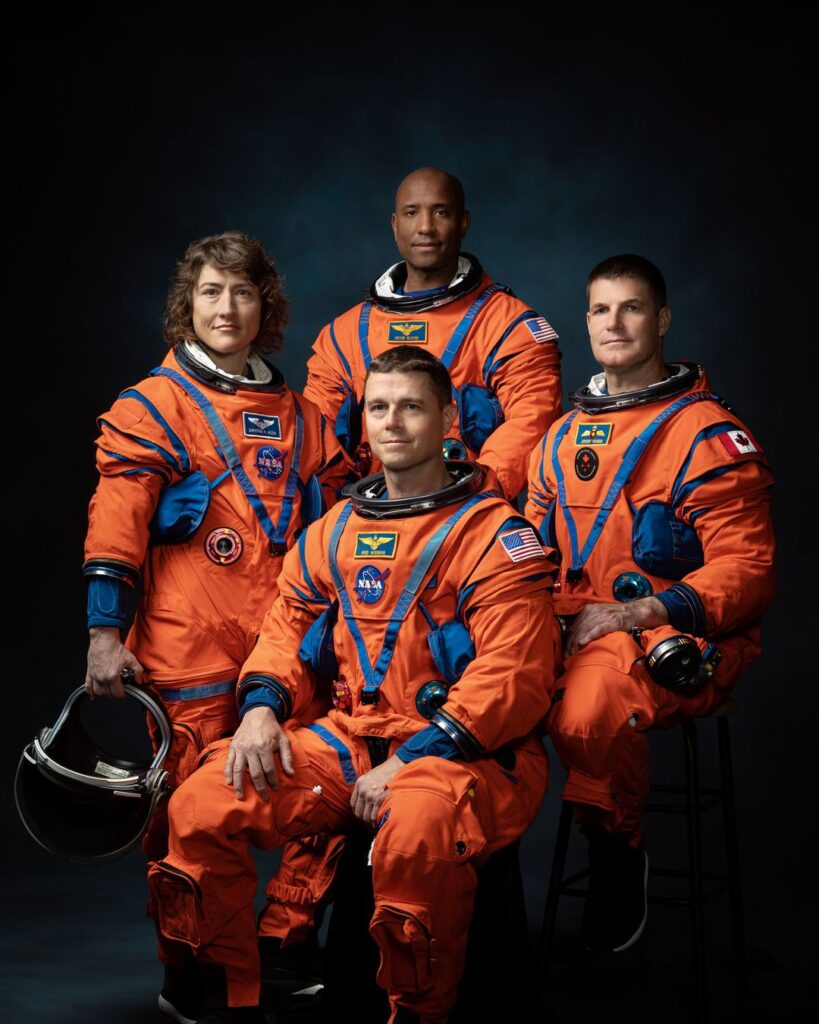
NASA’s “Artemis” space program is designed to set up a small space station that astronauts can use to more easily go down to the surface of the moon. Eventually, NASA will use what they learn from that experience to set up a similar space station for Mars exploration.
Canadian astronaut Jeremy Hansen was recently selected to be one of four astronauts to take part in one of the missions in Artemis. It’s called Artemis II and it will be a flight around the far side of the moon and back.
Canadian Space Agency (CSA) astronaut Hansen will fly in the Orion spacecraft, along with three Amercian astronauts: Christina Hammock Koch, Victor J. Glover, Jr. and Reid Wiseman.
The mission will begin in November 2024 and last about 10 days, covering more than a million kilometres. They will launch from the Kennedy Space Center in Florida and circle the Earth twice before heading to—and around—the moon. They will eventually splash down in the Pacific Ocean.
Their part of the Artemis mission is to make sure all of the systems on Orion work the way they’re supposed to. The astronauts will test the manual piloting of Orion as well as its “life support, exercise and habitation equipment,” according to the website of the Canadian Space Agency.
Hansen says that what excites him about the Artemis missions is the chance to look back at Earth and see it in its entirety. To see the “Earthrise,” as it’s known. (In this case, the Earthrise is similar to us on Earth seeing a sunrise—we see the whole of the sun as it “rises” up from the horizon.)
He points out that the first time humans saw an Earthrise in this way was in 1968 by the astronauts on Apollo 8.
“They went to observe the moon, but what touched them profoundly was seeing Earth. This time, when we return to the moon our eyes will be purposefully be focussed back on our planet and the challenges that face us right here at home… This view that the Apollo 8 astronauts shared with the world will be seen by a Canadian for the first time,” he says in a video on the ASC-CSA website.
The Artemis missions:
Artemis I, Nov. 16, 2022: The uncrewed Orion spacecraft launched from Florida and went thousands of kilometres past the moon. Its purpose was to test the SLS rocket, which launched Orion.
Artemis II, November 2024: Four astronauts will circle the Earth and then go around the far side of the moon before landing back on Earth 10 days later.
Artemis III: Slated for 2025 or later, this mission will fly four astronauts to the moon and land them on the its surface. There they will collect samples that will help scientists on Earth learn more about the moon.
After that, astronauts will connect Orion to a small space station called the Lunar Gateway, which will allow astronauts to go onto the surface of the moon and will also help scientists design similar missions to Mars in the future.
Think and Discuss
- How do you think space exploration helps us here on Earth?
2. Each Artemis mission costs billions of dollars. The entire Artemis program will cost more than $90 billion. Do you think it’s worth it? Why or why not?
3. Public opinions about space exploration and its high financial costs vary widely. If you wanted to get both sides of this discussion, you would need to find good sources of information. In other words, not just someone’s uneducated opinion–but people on both sides who are well informed and have studied the issues extensively. How would you find credible sources? List some.
4. What other NASA missions do you know about? What was their purpose?
5. Would you like to travel to Mars? What are the pros and cons (good and bad things) about travelling to Mars?
6. Here’s something fun… the Canadian Space Agency has just announced it has a new logo. Logos are symbollic and typically very thoughtfully designed. What does the CSA-ASC’s logo mean to you?

Links to more information
The Artemis II crew (NASA website): https://www.nasa.gov/specials/artemis-ii/
The Artemis program (Canadian Space Agency website): https://www.asc-csa.gc.ca/eng/astronomy/moon-exploration/artemis-missions.asp
Artemis II (Canadian Space Agency website): https://www.asc-csa.gc.ca/eng/missions/artemis-ii/mission.asp?fbclid=IwAR1SvADZAFsanZLP1hTTzPt93X0bCWNT1Dln0LOCZg66PHheEwbMyk74RxY
Artemis I: https://www.asc-csa.gc.ca/eng/astronomy/moon-exploration/artemis-missions.asp#artemis-i
Artemis III: https://www.asc-csa.gc.ca/eng/astronomy/moon-exploration/artemis-missions.asp#artemis-iii
Gizmodo.com article about what scientists learned from Artemis I: https://gizmodo.com/nasa-artemis-orion-sls-moon-mission-1849892615







